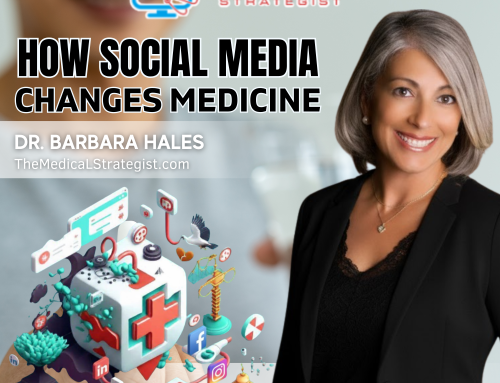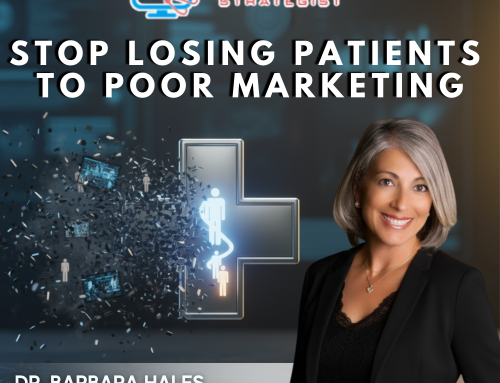Podcast: Play in new window | Download
Subscribe: RSS
In this episode, Barbara discusses:
- Keeping existing patients is more valuable than constantly seeking new ones.
- Most patients leave due to experience, not medical care.
- Personal, proactive follow-ups and small touches raise retention.
- Automated systems and regular patient education sustain loyalty.
- Loyal patients naturally bring in referrals.
Key Takeaways:
“The meeting highlighted that retaining patients is more cost-effective and impactful than seeking new ones, with most patients leaving due to poor experience rather than medical quality. Personal, proactive communication and using automated systems to follow up and educate are key to increasing patient loyalty, leading to higher returns and organic referrals.”
Connect with Barbara Hales:
🐦 Twitter: @DrBarbaraHales
📘 Facebook: facebook.com/theMedicalStrategist
🌐 Business Website: TheMedicalStrategist.com
🎙️ Show Website: MarketingTipsForDoctors.com
📧 Email: Barbara@TheMedicalStrategist.com
▶️ YouTube:@barbarahales
💼 LinkedIn: https://www.LinkedIn.com/in/barbarahales
TRANSCRIPTION. (221)
Introduction to Patient Retention
[0:00:02] Welcome to another episode of Marketing Tips for Doctors. I’m your host, Dr Barbara Hales. Today, we’re talking about one of the most significant hidden opportunities in your practice: patient retention. Most doctors spend time, energy, and money chasing new patients. But here’s the truth: keeping the patients you already have is where the real growth happens. Retaining patients means more trust, more referrals, and yes, more revenue. So today I’m going to show you how to turn one-time visits into lifelong relationships. We’ll cover what drives loyalty, the systems that make it easy, and how small touches create lasting impressions. Ready? Let’s get started.
The Value of Retention & Real Example
[~0:01:00] It costs five to seven times more to attract a new patient than it does to keep an existing one. Every time a patient walks out and doesn’t return, you’re not just losing that appointment. You’re losing their lifetime value, their referrals, and the credibility that comes with a satisfied patient base. Here’s a story to bring that home: a mid-sized orthopedic practice in Florida realized its follow-up system was broken. They focused on attracting new surgical patients through ads, but their post-op patients weren’t returning for physical therapy. Many went elsewhere after analyzing the data; they found that their reactivation rate had dropped below 40%. Hence, they hired a patient coordinator to make personal follow-up calls, asking how each patient was healing, offering guidance, and scheduling their next visit on the spot. Within six months of their return, the patient rate jumped 32% and revenue stabilized without increasing. Market spend, retention, not acquisition, made the difference.
Reasons Patients Leave
[~0:02:00] Now let’s talk about why patients leave. It’s rare because of the medical quality. Most patients leave because of experience. Here are the top five reasons. One: lack of communication —no reminders, no check-ins, no follow-up. Number two, feeling like a number, they don’t feel seen or remembered. Number three, confusing billing or scheduling practices. Number four: inconsistent staff interactions —a friendly doctor but a cold front desk —equals a poor memory. And number five, no emotional connection. They don’t feel like part of your practice community. Remember this, patients don’t leave for better medicine. They go for better experiences. Retention starts with culture. Every team member —from receptionist to physician —shapes that patient’s journey. Greet patients by name, make eye contact, smile; those small gestures mean the world. Train your staff to say, “It’s great to see you again,” instead of just “name, please.”
Staff Culture & Personal Touch
[~0:03:00] Here’s another truth to life. For example, a local dental office realized hundreds of inactive patients hadn’t been scheduled in over a year. Instead of sending another generic email, they mailed handwritten postcards signed by the dentist and staff, each reading, “We missed your smile.” Each card included a simple QR code to schedule an appointment online. It wasn’t a sales pitch; it was just a warm invitation. I. In the first month, 87 patients returned. By the end of the quarter, over 200 came back. Why? Because people respond to personal touches, not promotions. A great culture is vital, but systems make retention sustainable.
Automation & Feedback
[~0:04:00] Think of them as your digital support team. Start with an automated CRM or patient management platform that sends thank-you emails and post-visit reminders, and set up text notifications —not just for appointments, but also for check-ins, like, “How are you healing?” Use your patient portal to simplify communication and build trust, and never underestimate feedback surveys; they catch dissatisfaction early before it turns into a lost patient. Remember, automation doesn’t replace compassion. It reinforces it.
Education & Engagement
[~0:05:00] Education is one of the strongest retention tools you have when you teach, you lead, send out a monthly newsletter with health tips or updates. Create short videos explaining aftercare or new treatments. Host live Q&A sessions on social media. This keeps patients connected between visits and reinforces that you care beyond the appointment. If they learn from you regularly, they’ll stay with you consistently. Now let’s take retention a step further, because loyal patients become your best. Marketers encourage them to share reviews, refer friends, or attend patient appreciation events, but ensure it’s ethical and HIPAA-compliant. When you consistently deliver great experiences, you don’t have to ask for referrals. They happen naturally. Your most powerful marketing tool isn’t an ad; it’s a happy patient telling a friend about you, or a case study. Here are some great prompts. What’s one change you made that boosted retention in your practice? How do you build loyalty among busy patients? What metrics tell you retention is improving?
Recap & Call to Action
[~0:06:00] Let’s recap, patient retention isn’t about gimmicks. It’s about gratitude, consistency, and communication. Listen to your patients, follow up, educate, and engage. The more value they feel, the longer they stay, and the more they refer. If you’d like a free checklist or sample retention template, visit medicalstrategist.com/contact. You have only to ask and you shall receive. And don’t forget to subscribe to marketing tips for doctors. Wherever you listen to your favorite podcasts —whether it’s Spotify, Apple, or iTunes —well, I’m Dr. Barbara Hales. Thanks for joining me, and remember, your next big marketing win might just come from the patients you already have. See you next time.



